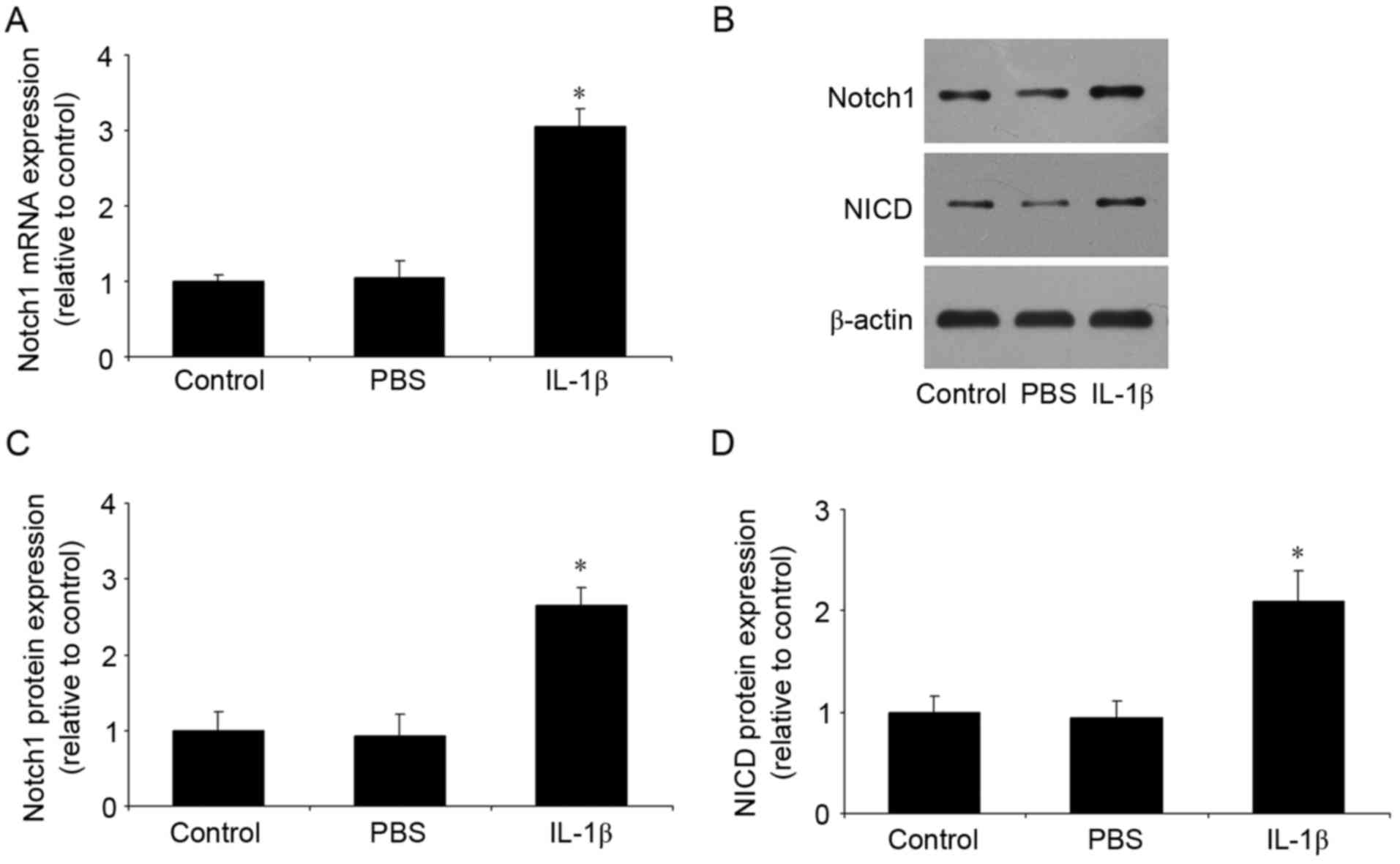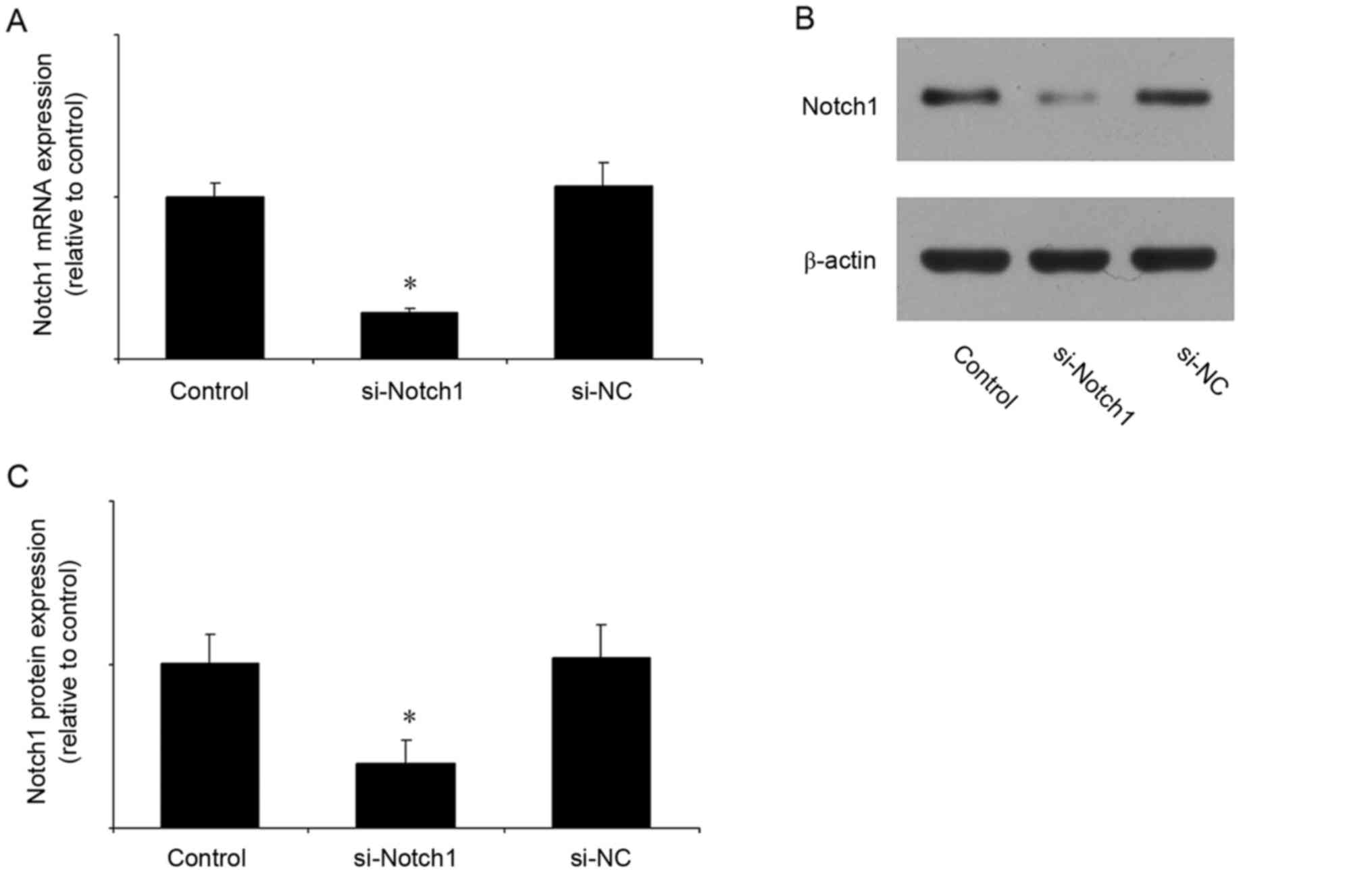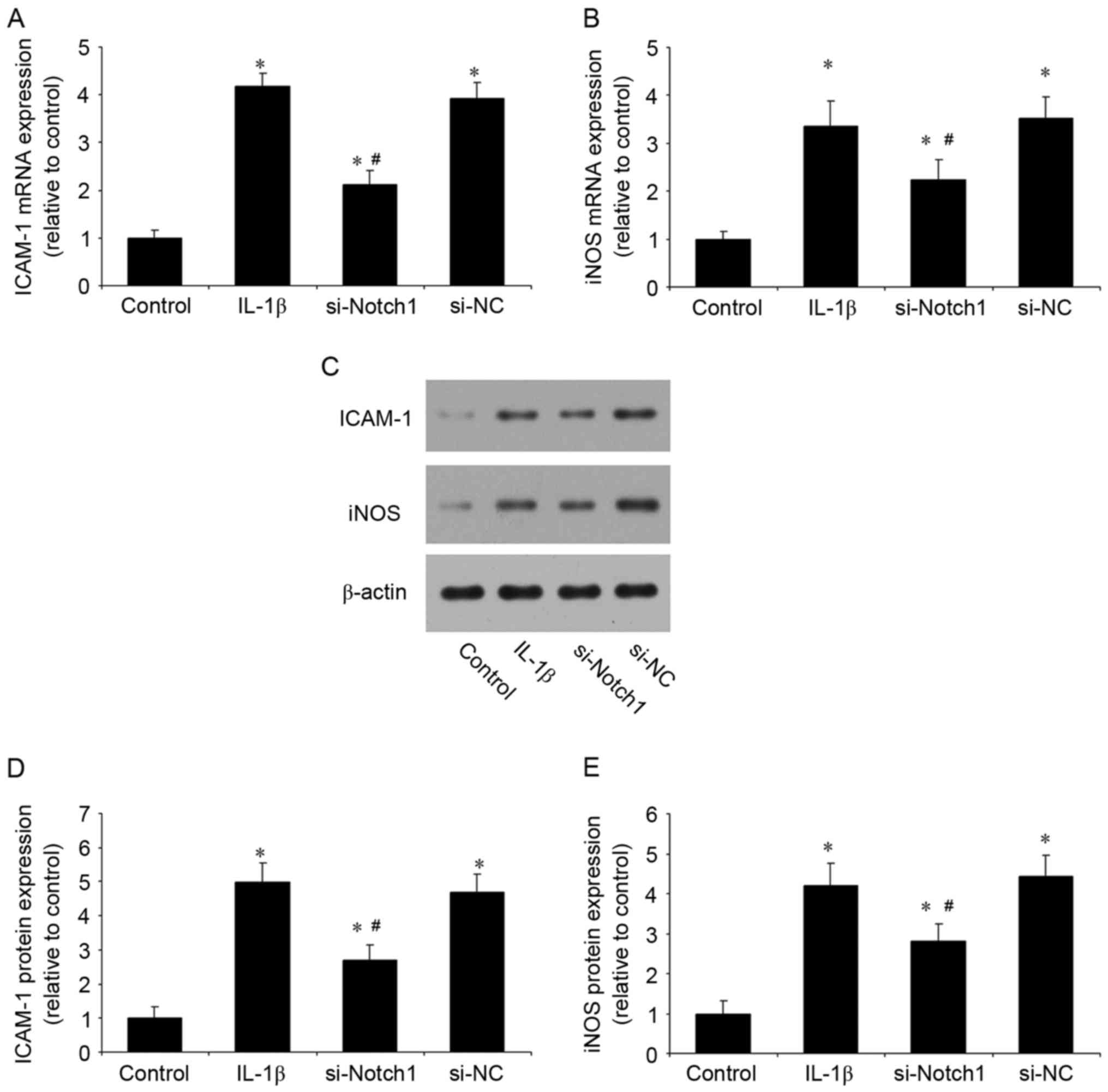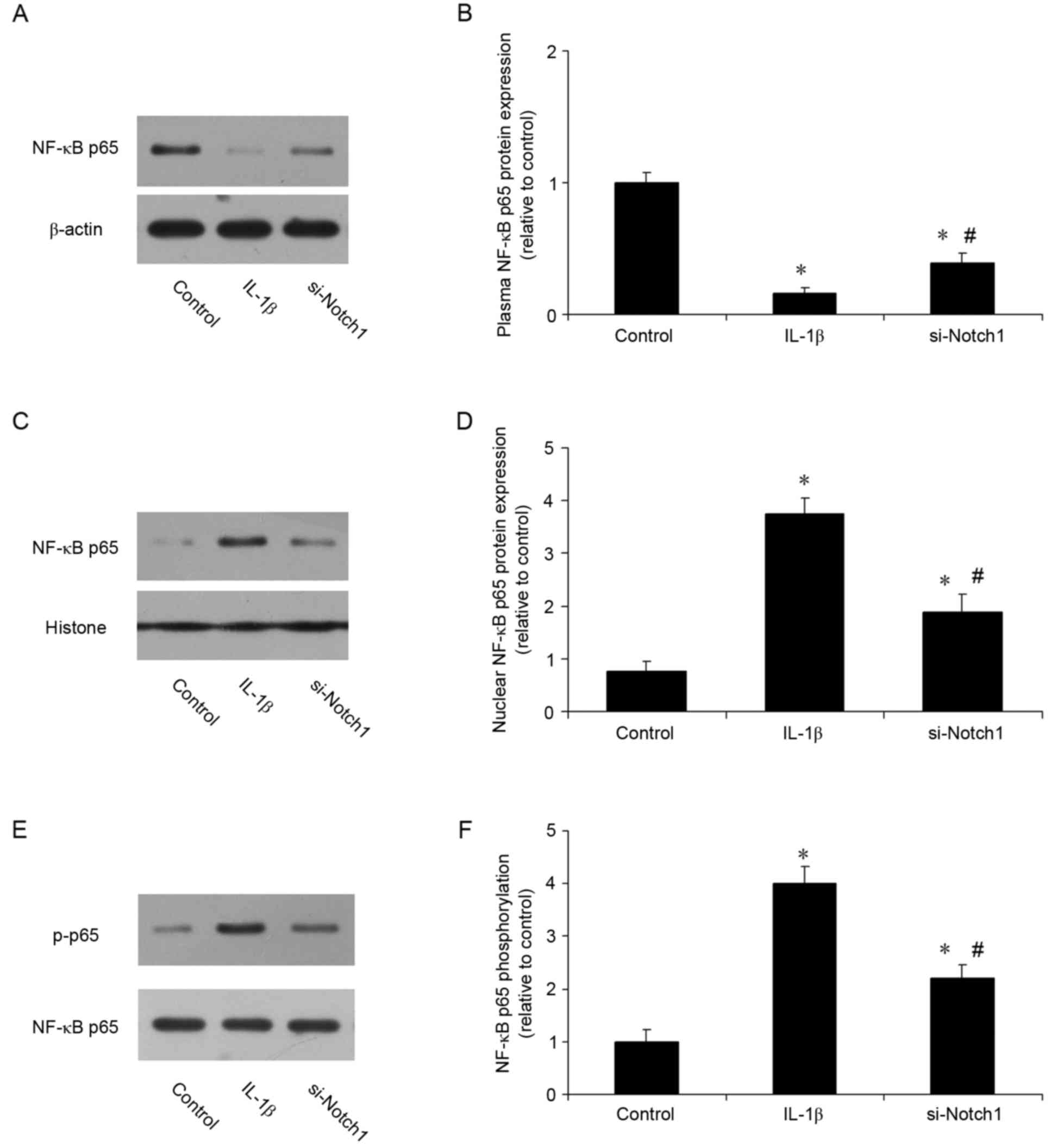Inhibition of Notch1 protects against IL-1β-induced inflammation and cartilage destruction in temporomandibular chondrocytes
- Authors:
- Published online on: April 26, 2017 https://doi.org/10.3892/mmr.2017.6511
- Pages: 4391-4397
Abstract
Introduction
Temporomandibular disorder (TMD) comprises a series of conditions, which cause pain and dysfunction in the muscles and joints between the lower jaw and the base of the skull. TMD is a complex and multifactorial disease, with physical, social and psychological factors usually associated with its etiology (1,2). Although progress has been made, the precise pathogenesis of TMD remains to be fully elucidated, which leads to difficulty in diagnosis and therapy. Usually, the temporomandibular cartilage withstands pressures of frequent jaw movement and biting hard food (3). Abnormal elevated intra-articular pressure and local inflammatory response are important in TMD. The differential expression of inflammatory cytokines has been found in patients with TMD, including monocyte chemotactic protein 1, interleukin (IL)-1 and IL-8 (4). Inflammation can also stimulate the production of matrix metalloproteinases (MMPs), downregulate the expression of tissue inhibitor of metalloproteinases (TIMPs) and accelerate the degradation of cartilage matrix (5). An imbalance between MMPs and TIMPs has been reported to be important in the progression of TMD (6).
IL-1 is a potent pro-inflammatory cytokine, which functions as the gatekeeper for inflammation (7). It is produced by a variety of cells and acts on almost every organ system of the body. IL-1 consists of two distinct proteins (IL-1α and IL-1β), which bind to the type 1 IL-1 receptor to activate a downstream pro-inflammatory pathway (8). IL-1β, a cytokine released by synovial cells and macrophages, causes inflammation of the articular cartilage (9).
The Notch signaling pathway consists of a family of four type I transmembrane receptors (Notch1-4), which undergo proteolytic processing by a furin-like convertase during transit to the cell surface (10). It is important in the growth, differentiation and survival of various cell types in diverse tissues (11). In the canonical signaling pathway, binding of a ligand triggers sequential receptor cleavage, and results in the release and translocation of the Notch1 intracellular domain (NICD) to the nucleus, where it functions as a transcriptional activator (12,13). Several lines of evidence have demonstrated that Notch is important in regulating the responsiveness of immune cells to stimulation and infection (14,15). Furthermore, inflammatory mediators can increase the expression of Notch (16), and the upregulation of Notch signaling elevates responses to interferon-γ, leading to increased expression of inflammatory cytokines in macrophages (17,18). However, the role of Notch1 signaling in IL-1β-stimulated temporomandibular chondrocytes remains to be elucidated.
The present study investigated whether the inhibition of Notch1 is able to inhibit inflammatory responses and cartilage destruction in TMD by establishing an in vitro model using temporomandibular chondrocytes.
Materials and methods
Isolation and culture of chondrocytes
The temporomandibular chondrocytes were isolated from the articular cartilage of 15 male Sprague-Dawley rats (6-week-old; 140–160 g). Animal care and all procedures were performed according to institutional guidelines and were approved by the Ethics Committee of Shandong University (Shangdong, China). All animals were housed in the same room on a 12 h light:dark cycle at 22°C and had full access to standard chow and water. All surgical procedures were performed under sodium pentobarbital anesthesia and all efforts were made to minimize suffering. Briefly, the harvested cartilage was minced and incubated in a trypsin-containing solution for 2 h at 37°C. The minced cartilage was then washed with phosphate-buffered saline (PBS; Sigma-Aldrich; KGaA Millipore, Darmstadt, Germany) and incubated with 0.2% collagenase (Sigma-Aldrich; KGaA Millipore) at 37°C overnight. Following digestion, the chondrocytes were collected via centrifugation at 800 × g for 15 min at 37°C and cultured in Dulbecco's modified Eagle's medium (DMEM; Gibco; Thermo Fisher Scientific, Inc., Waltham, MA, USA) containing 10% fetal calf serum (Gibco; Thermo Fisher Scientific, Inc.), 100 IU/ml penicillin and 100 µg/ml streptomycin (Gibco; Thermo Fisher Scientific, Inc.). The cells were serum-starved overnight prior to treatment. Cells in passages 1–3 were used in all experiments.
Cell treatment and gene inhibition
The primary temporomandibular chondrocytes were cultured at a density of 5,000 cells/well in DMEM at 37°C in an atmosphere of 5% CO2 and treated with 10 ng/ml IL-1β (Sigma-Aldrich; KGaA Millipore). The cells were harvested following incubation for 24 h. To inhibit the expression of Notch1, the cells were transfected with Notch1 small interfering (s)iRNA (GenePharma, Shanghai, China) or negative control siRNA using Lipofectamine 2000 (Invitrogen; Thermo Fisher Scientific, Inc.). Experiments were performed 24 h following transfection. The cells in the Notch1 group were stimulated with IL-1β following inhibition of Notch1 by siRNA.
Nuclear protein extraction
The nuclear proteins of the chondrocytes were extracted using an NE-PER Nuclear and Cytoplasmic Extraction Reagent kit (Pierce; Thermo Fisher Scientific, Inc.) according to the manufacturer's protocol. The protein was quantified using the bicinchoninic acid (BCA) method (Bio-Rad Laboratories, Inc., Hercules, CA, USA). All extracts were stored at −80°C until use.
Enzyme-linked immunosorbent assay (ELISA)
The inflammatory cytokines in the cell culture supernatant were measured using ELISA kits for tumor necrosis factor (TNF)-α and IL-6 (R&D Systems, Inc., Minneapolis, MN, USA), as described previously (19). All spectrophotometric readings were performed using an absorption spectrometer (Thermo Fisher Scientific, Inc.).
Measurement of mRNA expression using reverse transcription-quantitative polymerase chain reaction (RT-qPCR) analysis
Total RNA was extracted from the cultured cells using TRIzol (Invitrogen; Thermo Fisher Scientific, Inc.) and reverse transcribed to cDNA using SYBR-Green Supermix (Bio-Rad Laboratories, Hercules, CA, USA). The 1 µg mRNA levels were measured using qPCR analysis. The thermocycling conditions for PCR amplification were as follows: 95°C for 5 min, 36 cycles at 95°C for 10 sec, annealing at 56°C for 30 sec and elongation at 72°C for 30 sec. The primer sequences were as follows: Notch1, forward 5′-CGGGTCCACCAGTTTGAATG-3′ and reverse 5′-GTTGTATTGGTTCGGCACCAT-3′; intercellular adhesion molecule 1 (ICAM-1), forward 5′-TTGGAAGCC-TCATCCG-3′ and reverse 5′-CAATGTTGCGAGACCC-3′; inducible nitric oxide synthase (iNOS), forward 5′-GTTCTCAGCCCAACAATACAAGA-3′ and reverse 5′-GTGGACGGGTCGATGTCAC-3′; GAP DH, forward 5′-GGATGACCTTGCCCACAGCCT-3′ and reverse 5′-ATCTCTGC-CCCCTCTGCTGA-3′. qPCR was performed on the iCycler real-time PCR system (Bio-Rad Laboratories, Inc.) and relative quantification was performed using the comparative quantification (Cq) method (20).
Western blot analysis
The concentrations of protein extracted from chondrocytes were quantified using the BCA method with a protein assay kit (Beyotime Institute of Biotechnology, Nantong, China). The samples (50 µg) were separated on 10% SDS-PAGE and electrophoretically transferred onto a polyvinylidene difluoride membrane (GE Healthcare Life Sciences, Piscataway, NJ, USA). The blots were blocked for 2 h with 5% non-fat dry milk in Tris-buffered saline at room temperature and then incubated overnight with anti-Notch1 (catalog no. 36085; 1:1,000), anti-NICD (catalog no. 4147; 1:1,000), anti-ICAM (catalog no. 4915; 1:1,000), anti-iNOS (catalog no. 13120; 1:1,000) obtained from Cell Signaling Technology, Inc., Danvers, MA, USA. Additional antibodies used were anti-MMP-1 (catalog no. ab137332; 1:500, Abcam, Cambridge, MA, USA), anti-MMP-9 (catalog no. 2270; 1:2,000), anti-TIMP-1 (catalog no. 8946; 1:1,000), anti-nuclear factor (NF)-κB p65 (catalog no. 8242; 1:1,000), anti-phosphorylated (p)-NF-κB p65 (catalog no. 4806; 1:1,000), anti-histone (catalog no. 7631; 1:1,000) and anti-β-actin antibodies (catalog no. 3700; 1:1,000) all obtained from Cell Signaling Technology, Inc., at 4°C. Following washing with 0.1% TBS-Tween 20, the membranes were incubated with secondary horseradish peroxidase-conjugated IgG (catalog nos. ZB-2301 and ZB-2305; 1:1,000; ZSGB-BIO, Beijing, China) at room temperature for 2 h. The blots were then visualized using enhanced chemiluminescence with ECL reagents (Pierce; Thermo Fisher Scientific, Inc.).
Statistical analysis
Data are presented as the mean ± standard deviation from three independent experiments. SPSS software, version 13.0 (SPSS, Inc., Chicago, IL, USA) was used for statistical analysis. Intergroup comparisons were performed using Student's t-test (two-tailed) or one-way analysis of variance. P<0.05 was considered to indicate a statistically significant difference.
Results
IL-1β increases the expression of Notch1 and NICD
Following stimulation of the temporomandibular chondrocytes with IL-1β, the expression levels of Notch1 and NICD were measured using RT-qPCR and western blot analyses. As shown in Fig. 1A-D, no differences were found between the control group and the PBS group. However, compared with the control group, IL-1β significantly increased the mRNA and protein expression levels of Notch1, and the protein expression of NICD.
Notch1 siRNA reduces the mRNA and protein expression of Notch1
In the subsequent experiments, the expression of Notch1 was inhibited by siRNA. The efficiency of Notch1 siRNA was first verified. Compared with the control group, Notch1 siRNA significantly reduced the mRNA (Fig. 2A) and protein (Fig. 2B and C) expression levels of Notch1, whereas the negative control siRNA had no effect.
Notch1 inhibition reduces the IL-1β-induced inflammatory response
Inflammation is important in the pathogenesis of TMD. In the present study, following stimulation of the chondrocytes with IL-1β, the secretion of TNF-α and IL-6 were examined, as was the mRNA and protein expression levels of ICAM-1 and iNOS. Stimulation with IL-1β increased the levels of TNF-α and IL-6 in the supernatants, whereas the inhibition of Notch1 by siRNA reduced these levels and control siRNA had no effect (Fig. 3A and B). In addition, the inhibition of Notch1 significantly reduced the IL-1β-induced mRNA (Fig. 4A and B) and protein (Fig. 4C-E) expression levels of ICAM-1 and iNOS (Fig. 4). These results suggested that the inhibition of Notch1 suppressed the IL-1β-induced inflammatory response in chondrocytes.
Notch1 inhibition reduces the expression of MMPs and increases the expression of TIMP-1
An imbalance between MMPs and TIMPs has been confirmed to be important in the progression of TMD. The present study investigated the effect of inhibiting Notch1 on the expression levels of MMPs and TIMP-1. Compared with the control, IL-1β stimulation increased the expression levels of MMP-1 and MMP-9 (Fig. 5A-C), and reduced the expression of TIMP-1 (Fig. 5D). However, the inhibition of Notch1 had the opposite effect, reducing the expression levels of MMPs and increasing the expression of TIMP-1.
Notch1 inhibition suppresses IL-1β induced activation of NF-кB in chondrocytes
The present study also investigated whether the protective effects of inhibiting Notch1 involved the NF-кB signaling pathway. The nuclear translocation of NF-κB p65 was analyzed using western blot analysis. As shown in Fig. 6A-D, the localization of NF-κB p65 was predominantly cytoplasmic prior to IL-1β stimulation, however, it was translocated to the nucleus when cells were stimulated with IL-1β. The inhibition of Notch1 suppressed this IL-1β-induced p65 nuclear translocation. The expression of p-p65 was also measured. Compared with the control, IL-1β increased the expression of p-p65 3-fold, whereas inhibition of Notch1 reduced the IL-1β-induced expression of p-p65 (Fig. 6E and F). These results suggested that the protective effect of Notch1 inhibition occurred, at least in part, through the NF-кB signaling pathway.
Discussion
TMD is an assorted set of clinical conditions characterized by pain and dysfunction of the masticatory muscles in the temporomandibular joint (TMJ) (21). The prevalence of TMD varies between 5 and 86% depending on different epidemiological studies, diagnostic criteria and methods of assessment (22). According to the latest understanding, inflammatory cytokines are the most important pathogenic factors involved in the pathogenesis of TMD (23), responsible for the loss of metabolic homeostasis by promoting catabolic and destructive processes. Among the numerous representatives of these inflammatory cytokines, the highest importance is attributed to IL-1β, TNF-α and IL-6. In the present study, temporomandibular chondrocytes were stimulated with IL-1β. Compared with the control group, IL-1β significantly induced the inflammatory response in vitro, including the secretion of TNF-α and IL-6, and mRNA and protein expression of ICAM-1 and iNOS. These results were accordance with previous findings in vivo (24).
MMPs are a family of >20 metalloenzymes, which are crucial in tissue remodeling and cartilage degradation due to their ability to degrade extracellular matrix (25). TIMPs are considered to be specific inhibitors of MMPs. An imbalance between the activity of MMPs and their inhibitors is considered to underlie cartilage destruction. The expression of MMP-2 and MMP-9 has been reported to increase in the rat trigeminal ganglion during the development of TMJ inflammation (26). In the present study, it was found that IL-1β stimulation increased the expression of MMP-1 and MMP-9, and reduced the expression of TIMP-1, whereas the inhibition of Notch1 by siRNA reduced the expression of MMPs and increased the expression of TIMP-1. Therefore, maintaining the balance of MMPs/TIMP-1 is the precise mechanism by which the inhibition of Notch1 prevents cartilage matrix degradation. This prompted investigation of the probable cell signaling transduction.
NF-κB is pivotal in regulating inflammation-associated genes (27). Various stimuli, including pro-inflammatory cytokines, lead to the nuclear translocation of NF-κB p65 and subsequently to the upregulated transcription of various proinflammatory cytokines, including IL-1, TNFα, IL-6 and IL-8 (28). NF-κB remains inactive in the cytoplasm through interaction with the inhibitory protein, inhibitor κB (IκB). The activation of NF-κB requires the phosphorylation and subsequent degradation of IκBα (29). It has been demonstrated that the phosphorylation of p65 is critical for binding to its target sites on DNA (30). Considering NF-κB is a pivotal regulator of the inflammatory response, the cross-talk between IL-1β and NF-κB in chondrocytes may be one of the major causes of TMJ inflammation. As expected, stimulation with IL-1β in the present study induced the nuclear translocation and phosphorylation of NF-κB p65, with an increased expression of inflammatory cytokines, including TNFα, IL-6, ICMA-1 and iNOS.
In conclusion, the results of the present study provide novel insights into the regulatory mechanisms of Notch1 in temporomandibular chondrocytes during TMD. IL-1β stimulation induced Notch1, and subsequent variation was associated with NF-κB pathway, which may be an important pathogenetic factor in the development of TMD. The present study, to the best of our knowledge, is the first to provide evidence that the inhibition of Notch1 effective treated TMD. However, further in vivo experiments are required to identify novel and potent agents for the prevention and treatment of TMD through the inhibition of Notch1.
Acknowledgements
This study was supported by the Science and Technology Development Plans of Shandong Province (grant no. 2014GSF118027) and the Specialized Research Fund for the Doctoral Program of Higher Education of China (grant no. 20120131110074).
References
|
Reissmann DR, John MT, Schierz O and Wassell RW: Functional and psychosocial impact related to specific temporomandibular disorder diagnoses. J Dent. 35:643–650. 2007. View Article : Google Scholar | |
|
Kiener HP and Karonitsch T: The synovium as a privileged site in rheumatoid arthritis: Cadherin-11 as a dominant player in synovial pathology. Best Pract Res Clin Rheumatol. 25:767–777. 2011. View Article : Google Scholar | |
|
Wu M, Xu T, Zhou Y, Lu H and Gu Z: Pressure and inflammatory stimulation induced increase of cadherin-11 is mediated by PI3K/Akt pathway in synovial fibroblasts from temporomandibular joint. Osteoarthritis Cartilage. 21:1605–1612. 2013. View Article : Google Scholar | |
|
Slade GD, Conrad MS, Diatchenko L, Rashid NU, Zhong S, Smith S, Rhodes J, Medvedev A, Makarov S, Maixner W and Nackley AG: Cytokine biomarkers and chronic pain: Association of genes, transcription, and circulating proteins with temporomandibular disorders and widespread palpation tenderness. Pain. 152:2802–2812. 2011. View Article : Google Scholar : | |
|
Dai SM, Shan ZZ, Nakamura H, Masuko-Hongo K, Kato T, Nishioka K and Yudoh K: Catabolic stress induces features of chondrocyte senescence through overexpression of caveolin 1: Possible involvement of caveolin 1-induced down-regulation of articular chondrocytes in the pathogenesis of osteoarthritis. Arthritis Rheum. 54:818–831. 2006. View Article : Google Scholar | |
|
Okamoto K, Kiga N, Shinohara Y, Tojyo I and Fujita S: Effect of interleukin-1beta and dehydroepiandrosterone on the expression of lumican and fibromodulin in fibroblast-like synovial cells of the human temporomandibular joint. Eur J Histochem. 59:24402015. View Article : Google Scholar : | |
|
Dinarello CA: A clinical perspective of Il-1β as the gatekeeper of inflammation. Eur J Immunol. 41:1203–1217. 2011. View Article : Google Scholar | |
|
Korherr C, Hofmeister R, Wesche H and Falk W: A critical role for interleukin-1 receptor accessory protein in interleukin-1 signaling. Eur J Immunol. 27:262–267. 1997. View Article : Google Scholar | |
|
Yudoh K, Nguyen vT, Nakamura H, Hongo-Masuko K, Kato T and Nishioka K: Potential involvement of oxidative stress in cartilage senescence and development of osteoarthritis: Oxidative stress induces chondrocyte telomere instability and downregulation of chondrocyte function. Arthritis Res Ther. 7:R380–R391. 2005. View Article : Google Scholar : | |
|
Weng AP, Ferrando AA, Lee W, Morris JP IV, Silverman LB, Sanchez-Irizarry C, Blacklow SC, Look AT and Aster JC: Activating mutations of notch1 in human T cell acute lymphoblastic leukemia. Science. 306:269–271. 2004. View Article : Google Scholar | |
|
Weng AP and Aster JC: Multiple niches for notch in cancer: Context is everything. Curr Opin Genet Dev. 14:48–54. 2004. View Article : Google Scholar | |
|
Selkoe D and Kopan R: Notch and presenilin: Regulated intramembrane proteolysis links development and degeneration. Annu Rev Neurosci. 26:565–597. 2003. View Article : Google Scholar | |
|
Bray SJ: Notch signalling: A simple pathway becomes complex. Nat Rev Mol Cell Biol. 7:678–689. 2006. View Article : Google Scholar | |
|
Eagar TN, Tang Q, Wolfe M, He Y, Pear WS and Bluestone JA: Notch 1 signaling regulates peripheral T cell activation. Immunity. 20:407–415. 2004. View Article : Google Scholar | |
|
Palaga T, Miele L, Golde TE and Osborne BA: TCR-mediated notch signaling regulates proliferation and IFN-gamma production in peripheral T cells. J Immunol. 171:3019–3024. 2003. View Article : Google Scholar | |
|
Ando K, Kanazawa S, Tetsuka T, Ohta S, Jiang X, Tada T, Kobayashi M, Matsui N and Okamoto T: Induction of notch signaling by tumor necrosis factor in rheumatoid synovial fibroblasts. Oncogene. 22:7796–7803. 2003. View Article : Google Scholar | |
|
Monsalve E, Pérez MA, Rubio A, Ruiz-Hidalgo MJ, Baladrón V, Garcia-Ramirez JJ, Gómez JC, Laborda J and Diaz-Guerra MJ: Notch-1 up-regulation and signaling following macrophage activation modulates gene expression patterns known to affect antigen-presenting capacity and cytotoxic activity. J Immunol. 176:5362–5373. 2006. View Article : Google Scholar | |
|
Palaga T, Buranaruk C, Rengpipat S, Fauq AH, Golde TE, Kaufmann SH and Osborne BA: Notch signaling is activated by TLR stimulation and regulates macrophage functions. Eur J Immunol. 38:174–183. 2008. View Article : Google Scholar | |
|
Pastrana JL, Sha X, Virtue A, Mai J, Cueto R, Lee IA, Wang H and Yang XF: Regulatory T cells and atherosclerosis. J Clin Exp Cardiolog. 2012 Suppl 12:S22012. | |
|
Livak KJ and Schmittgen TD: Analysis of relative gene expression data using real-time quantitative PCR and the 2(−Delta Delta C(T)) method. Methods. 25:402–408. 2001. View Article : Google Scholar | |
|
Kou XX, Wu YW, Ding Y, Hao T, Bi RY, Gan YH and Ma X: 17β-estradiol aggravates temporomandibular joint inflammation through the NF-κB pathway in ovariectomized rats. Arthritis Rheum. 63:1888–1897. 2011. View Article : Google Scholar | |
|
Aliko A, Ciancaglini R, Alushi A, Tafaj A and Ruci D: Temporomandibular joint involvement in rheumatoid arthritis, systemic lupus erythematosus and systemic sclerosis. Int J Oral Maxillofac Surg. 40:704–709. 2011. View Article : Google Scholar | |
|
Wojdasiewicz P, Poniatowski ŁA and Szukiewicz D: The role of inflammatory and anti-inflammatory cytokines in the pathogenesis of osteoarthritis. Mediators Inflamm. 2014:5614592014. View Article : Google Scholar : | |
|
Kaneyama K, Segami N, Yoshimura H, Honjo M and Demura N: Increased levels of soluble cytokine receptors in the synovial fluid of temporomandibular joint disorders in relation to joint effusion on magnetic resonance images. J Oral Maxillofac Surg. 68:1088–1093. 2010. View Article : Google Scholar | |
|
Parks WC, Wilson CL and López-Boado YS: Matrix metalloproteinases as modulators of inflammation and innate immunity. Nat Rev Immunol. 4:617–629. 2004. View Article : Google Scholar | |
|
Nascimento GC, Rizzi E, Gerlach RF and Leite-Panissi CR: Expression of MMP-2 and MMP-9 in the rat trigeminal ganglion during the development of temporomandibular joint inflammation. Braz J Med Biol Res. 46:956–967. 2013. View Article : Google Scholar : | |
|
Baldwin AS Jr: The NF-kappa B and I kappa B proteins: New discoveries and insights. Annu Rev Immunol. 14:649–683. 1996. View Article : Google Scholar | |
|
Barnes PJ and Karin M: Nuclear factor-kappaB: A pivotal transcription factor in chronic inflammatory diseases. N Engl J Med. 336:1066–1071. 1997. View Article : Google Scholar | |
|
Ogata N, Yamamoto H, Kugiyama K, Yasue H and Miyamoto E: Involvement of protein kinase C in superoxide anion-induced activation of nuclear factor-kappa B in human endothelial cells. Cardiovasc Res. 45:513–521. 2000. View Article : Google Scholar | |
|
Li Q and Verma IM: Nf-kappaB regulation in the immune system. Nat Rev Immunol. 2:725–734. 2002. View Article : Google Scholar |















